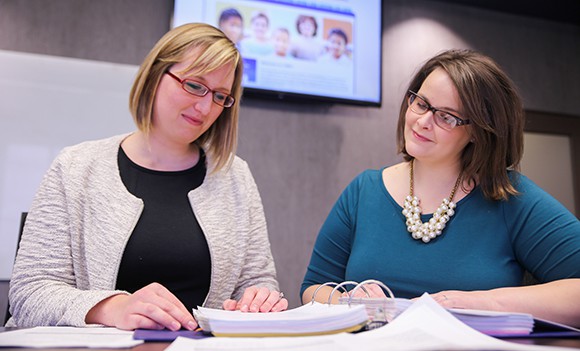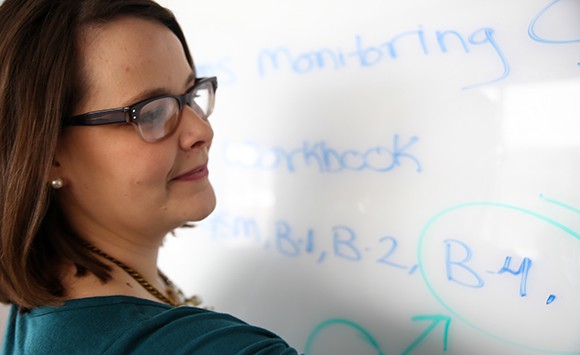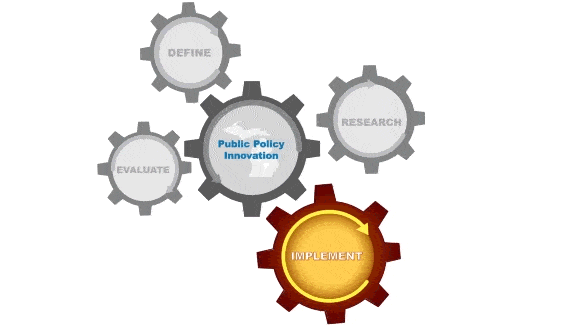Bringing projects from thought to practice takes a special set of skills in implementation. How implementation benefits our clients is the focus of this installment of In the Gears, a series that highlights the tools PSC uses to turn the gears of public policy innovation. Other areas of focus include evaluation, facilitation, strategic counsel, and strategic planning.
Michelle Richard

Michelle Richard and Sarah Greer
Lynne Clark

Sarah Greer
The depth and breadth of Public Sector Consultants’ knowledge and skill — the “gears” used in the firm’s work — yield valuable contributions to shaping policy on behalf of PSC’s clients.
But one program in particular allows PSC to really focus on how to aid a client in implementing policy.
The Continuous Improvement and Monitoring System (CIMS) is a tool built and managed by PSC to help the Michigan Department of Education (MDE) streamline compliance with federal regulations. The end result: educators can spend less time on paperwork and more time teaching students.
CIMS is the online tool used by MDE’s Office of Special Education to promote positive outcomes and ensure compliance with federal and state regulations: the Individuals with Disabilities Education Act (IDEA) of 2004 and the Michigan Administrative Rules for Special Education. Not only does it provide a simple method for the state to ensure local districts are complying with regulations, but it creates a two-way platform for sharing information between districts and the MDE.

“Back in the day, the monitoring team over at the MDE would take a huge binder around the state, from district to district, to conduct the monitoring in person,” recalls Lynne Clark, project assistant within PSC’s education division. “Now, it’s all done online.”
It all started back in 2005, when the MDE approached Jeff Williams, now PSC’s chief executive officer, about converting that binder into an online system. Williams has a long history of working with the agency on policy and program development.
“They came to Jeff with this four-inch binder and asked if PSC could turn it into an electronic workbook,” says Clark. “He collaborated with the MDE and technology experts and came up with a solution. Then the MDE said, ‘Great. And by the way, can you also add these other things?’ So by the time it was done, CIMS included a great deal of new functionality.”
The platform was launched in 2005, well ahead of other states’ efforts to digitize this compliance system. It has continuously undergone improvements to evolve alongside programmatic and regulatory needs.
The CIMS program draws on multiple aspects of PSC’s strengths, from program evaluation and technology to communication and facilitation. PSC staff designed much of the website’s interface, and oversees an IT firm (Agate Software) to develop and maintain the system. PSC staff also trains local district users, supervises a help desk (led by a team at Courtland Consulting), and meets regularly with MDE staff to make sure the system is functioning well and to identify areas for improvement.
“We help the department communicate with local districts about this work,” says Sarah Greer, a consultant in PSC’s education division. “We do a lot of training — we host webinars and maintain a website. We want to make it as easy as possible for people in the field to meet their compliance obligations, so that they can spend their time working in classrooms and doing things that make the most difference for kids.”
According to Michelle Richard, a senior consultant in PSC’s education division, the close working relationship between PSC and MDE staff lies at the heart of the program’s success.
“We’ve been able to maintain a collaborative relationship with the department,” she says. “We meet with department staff weekly to make sure that the system is matching their needs. MDE staff bring so much expertise in this subject area, and we’re really able to help them translate that into a tech system that delivers what they need.”
MDE staff also value the relationship.
“We are fortunate to have a long standing partnership with PSC,” says Teri Johnson Chapman, director of the Office of Special Education. “They’ve been a critical partner in advancing our monitoring efforts and improving outcomes for students in Michigan. We’ve really appreciated PSC’s willingness to tackle challenging policy questions and help us identify solutions that make sense for students, districts, and the state. The team is hardworking, flexible, smart, and fun. They push us to think differently about our work, and we’ve been able to build strong systems because of our close collaboration.”
Often, that collaboration includes a great deal of facilitation work to tease out the best direction for the program, according to Richard.
“Many times, staff will come to us with an idea or concept, and we have to pull that thread and talk it through in several meetings to develop that thought into a functioning part of the system,” she says. “That is one thing our team — PSC and MDE — has been able to do successfully, many times over.”
According to Richard, maintaining that open, collaborative spirit over time with agency staff has been especially fruitful and rewarding.
“We’re honored that we’ve been able to build such a strong relationship with the Office of Special Education,” says Richard. “We’re really able to think through ideas with them. They help us think through programming ideas, and we help them think through policy ideas. It is truly collaborative. We don’t just go off in a corner and do work and come back with something, and say, ‘Here, client, it’s done.’ We’re sitting in the room hashing it out with them, and I think that’s one of the coolest parts about this project.”


